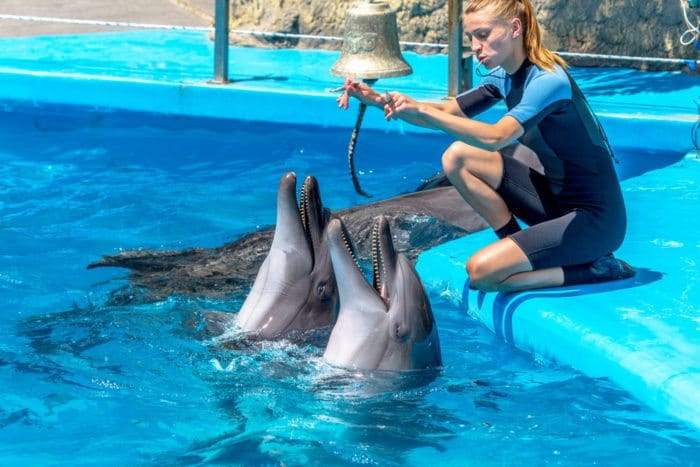Why We Love It
-
$33,600Potential Avg. Salary
-
11.1%Job Growth Rate
-
Growing DemandJob Outlook
-
High Job SatisfactionCareer Attribute
Dolphin and marine trainers care for dolphins that are kept in captivity. They ensure marine mammals receive the care they need by training them to feel comfortable around people, to subject to medical procedures and evaluations, to perform tricks, and/or to swim in confined areas with people.
Recommended Schools
What is a Dolphin and Marine Trainer?
The following job responsibilities are common for individuals in dolphin and marine trainer roles:
- Provide care for marine mammals: dolphins, whales, sea lions, seals, and walruses
- Use the principles of operant conditioning to train marine mammals to conduct certain activities, such as performing tricks for shows or submitting to medical evaluations
- Educate the public about marine mammals
- Operate scuba diving gear to conduct job responsibilities and socialize with marine mammals
A Day in the Life
Dolphin and marine trainers care for marine mammals—dolphins, whales, sea lions, seals, and walruses—that are kept in captivity for aquariums, zoos, theme parks, or research facilities. They form trusting relationships with the marine mammals in their care and use operant conditioning, a form of positive reinforcement, to train the mammals in their care to perform certain actions on command. The actions perform may be for entertainment, but they are also commonly used to ensure proper care.
For example, when dolphin trainers pet dolphins, they are not simply showing affection for the animal—they’re training it to allow ultrasounds to be taken when health concerns are suspected. Dolphin and marine trainers certainly train their animals to perform tricks and entertain the public, but their first and foremost goal as trainers is to ensure marine mammals are trained to allow for adequate care by humans while held in captivity.
Beyond training dolphins and other marine mammals, trainers also commonly lead shows and presentations of the skills of the animals they care for, requiring showmanship and public speaking skills. For example, dolphin and marine trainers at Sea World host shows where they educate large audiences about marine mammals, and issue commands to their trained animals to encourage them to perform tricks for the audience.
Typical Work Schedule
Dolphins and other marine mammals need care around the clock, so trainers may be required to work many different shifts on weekdays, weekends, and holidays. Most dolphin and marine trainers work full-time schedules, and overtime may be required on occasion.
Typical Employers
Most dolphin and marine trainers work for aquariums, zoos, theme parks like Sea World, or other attraction-based businesses that offer marine life exhibitions. Some may also work in research as marine biologists or oceanographers.
Recommended Schools
How To Become a Dolphin and Marine Trainer
For most dolphin and marine trainer positions, a bachelor’s degree is either required or preferred. Common degree programs for aspiring dolphin and marine trainers include animal husbandry, animal sciences, zoology, marine biology, veterinary sciences, or general biology. These programs are focused on educating students in the physiology of and care for animals, particularly marine mammals. Additional coursework in communications, theater, or public speaking can also be beneficial as marine trainers are also commonly responsible for conducting educational and entertaining exhibitions.
While a bachelor’s degree is usually a prerequisite for dolphin and marine trainer roles, it is rarely the only prerequisite. Most employers also want prospective trainers to have professional experience working with large animals. The experience doesn’t necessarily have to be working with marine mammals—in many cases, a history of working with horses or animals in a zoo is sufficient. Entry-level or volunteer positions at stables, farms, or zoos can be helpful in providing students with relevant experience when applying for dolphin and marine trainer roles.
Dolphin and marine trainers must also be very adept at navigating water in order to perform their roles. They must be proficient swimmers and capable of operating and wearing scuba diving gear so that they can work with marine mammals in their natural environments. Taking swimming and scuba diving lessons prior to searching for work as a dolphin or marine trainer can showcase your commitment to the role to prospective employers and prove your capabilities for navigating systems of water.
Dolphin and Marine Trainer Salary Data
We’ve provided you the following to learn more about this career. The salary and growth data on this page comes from recently published Bureau of Labor Statistics data while the recommendations and editorial content are based on our research.
National Anual Salary
Low Range
$20,640Average
$33,600High Range
$57,170National Hourly Wage
Low Range
$10/hrAverage
$16/hrHigh Range
$27/hrHow do Dolphin and Marine Trainer salaries stack up to other jobs across the country? Based on the latest jobs data nationwide, Dolphin and Marine Trainer's can make an average annual salary of $33,600, or $16 per hour. This makes it an Above Average Salary. On the lower end, they can make $20,640 or $10 per hour, perhaps when just starting out or based on the state you live in.
Salary Rankings And Facts
#644 Nationally for All Careers
Programs and Degrees
Here are the most common degrees for becoming a Dolphin and Marine Trainer. a is usually recommended and specifically a degree or coursework that prepares you for the particular field, see below.
Highest Education Among Dolphin and Marine Trainers
- 1.1% Doctorate
- 3.3% Masters
- 26% Bachelors
- 8.1% Associates
- 27.3% College
- 28% High School
- 6.1% Less than High School
Job Growth Projections and Forecast
2014 Total Jobs
36,8002024 Est. Jobs
40,900Job Growth Rate
11.1%Est. New Jobs
4,100How does Dolphin and Marine Trainer job growth stack up to other jobs across the country? By 2024, there will be a change of 4,100 jobs for a total of 40,900 people employed in the career nationwide. This is a 11.1% change in growth over the next ten years, giving the career a growth rate nationwide of Below Average.
Growth Rankings And Facts
#159 Nationally for All Careers
What Companies Employ The Most Dolphin and Marine Trainers
| Industry | Current Jobs | New Jobs Needed | % Increase |
|---|---|---|---|
| Self-employed workers | 15,900 | 2,400 | 3% |
| Animal production and aquaculture | 6,200 | 500 | 1% |
| Support activities for agriculture and forestry | 4,900 | 600 | 1% |





















